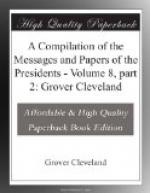On the other hand, the course of Messrs. Mudge and Featherstonhaugh being confined, except where they ascended Mars Hill, to the valleys of the streams, they were for the most part excluded from a prospect. In describing the view from Mars Hill, however, they have pictured in most accurate terms the true features of the country:
“The character of the country may be well discerned and understood from this insulated hill. It presents to the eye one mass of dark and gloomy forest to the utmost limits of sight, covering by its umbrageous mantle the principal rivers, minor streams, and scanty vestiges of the habitation of man.”
This description can only agree with that of a vast table-land into which the streams cut so deep and form such narrow valleys as to be invisible.
But if a chain of highlands, or even an “axis of maximum elevation,” had existed as they lay it down, within 20 miles, it would have been visible, and it need not be said that they would not have failed to describe it. The inconsistency between their map and this true and forcible description of the features of the country is apparent.
The same general character of table-land is found to the north of the St. John above the Grand Falls. Its first important northern tributary is the Grand River. In ascending this stream the level of the table-land is soon reached. The river runs between banks of very moderate elevation and on a regular slope, and although running with great rapidity upon a pebbly bed it is yet so tortuous that while its distance from its mouth to the Wagansis portage in a straight line is no more than 13 miles the meanders of its channel amount to 30.
On the Wagansis portage the table-land is terminated by a ridge whose summit is elevated 264 feet above the wagansis[33] of Grand River. It was at first believed that this, although of small elevation, was a dividing ridge, and that it might correspond to one construction which has, although inaccurately, been put on the treaty of 1783. This belief was speedily removed, for the rivulet on its northern side was found to be cut off from the Restigouche by the Sugar Loaf Mountain, and is therefore a branch either of the Grand River or of the stream which falls into the St. John immediately above the Grand Falls. The height of land which divides this rivulet from the wagan of the Restigouche is not elevated above the former more than 117 feet. There is, in fact, at this place a gap 5 or 6 miles in breadth in the great system of mountains which extend from the Gulf of St. Lawrence at the Bay des Chaleurs to the river St. Lawrence near the Temiscouata portage. At the northern verge of the table-land which has been described, and near the mouth of Green River, rises to the height of about 1,600 feet a mountain known from the name of that stream. This is, like Mars Hill, isolated, and affords an extensive view. To the north and west the prospect is bounded by a continuous line of horizon, which, instead of being obviously below the level of the eye, as in the view of the disputed territory from Mars Hill, is evidently of even greater height than the Green River Mountain itself.




